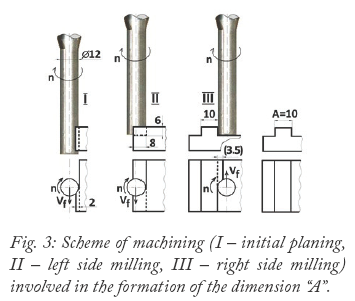Related Resources: Manufacturing
Accuracy of MDF Milling Process
Manufacturing Processes and Design
Tolerances, Engineering Design & Limits & Fits
Analysis of Dimensional Accuracy of MDF Milling Process
This resource requires a Premium Membership
Open and view: Analysis of Dimensional Accuracy of MDF Milling Process
The aim of this paper was to present the experimental study of MDF milling process’s dimensional accuracy conducted by means of standard CNC router. The analysis of long- and short-term’s machining accuracy was based on ISO 21747 2006 study involved the side milling and grooving processes. It turned out that the significant tool wear can reduce a machining accuracy from IT12 to IT17 (ISO 286 2010) and for an adequate reaction to the progression of tool wear it is a workpiece rather than a tool which should be measured (monitoring of decrease in cutting diameter can be useless when side milling process is involved).

KEYWORDS: Dimensional accuracy, MDF milling, CNC router.
Introduction
Medium density fiberboard (MDF) is an industrially manufactured wood-based material, which is commonly used in a large-scale production of furniture, interior fitments, shop fitting and many other similar products. The well known advantages of MDF are dimension stability and high level of machinability (Gaitonde et al. 2008). The uniform structure of MDF allows for very precise machining (Aguilera 2010). The furniture components made of MDF are frequently manufactured with the use of milling machines (for example CNC routers). Therefore some basic aspects of MDF milling process (cutting forces, tool wear, surface roughness, burr formation, machining accuracy etc.) have been studied and discussed in the specialist scientific literature (Aguilera et al. 2000, Ohuchi and Murase 2001, 2005, 2006, Ohuchi et al. 2008, Davim et al. 2009). The advanced analysis of dimensional accuracy of MDF milling process led even to the development of automatic, adaptive control grooving system corresponding to progression of tool wear (Ohuchi and Murase 2006). The development of such system is essential since the long-term maintaining of low level of cutting errors is a very important problem.
Related:
- Machine Shop and Manufacturing Definitions
- Electrical Discharge Machining ( EDM ) Design Consideration Process Capabilities
- Swiss Screw Machine & Manufacturing Review
- Multi-Axis CNC Machining Crankshaft
- Why DFM/DFA is Business Critical
- Design for Manufacturability and Concurrent Engineering
- Design for Manufacturability and Assembly DFM DFMA
- Overview Design for Manufacturability
- Milling Machines and Process Review